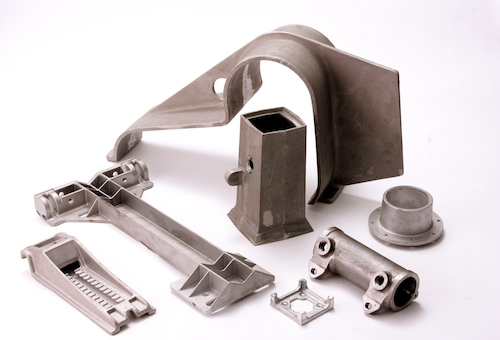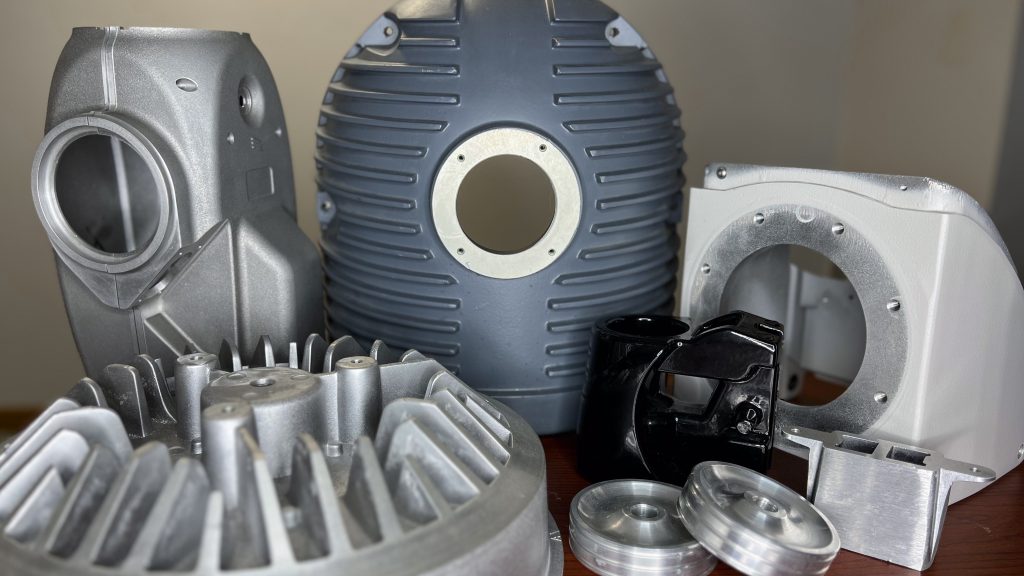The expertise that drives Wisconsin Aluminum Foundry forward
Wiki Article
Uncovering the Conveniences and Practical Use Aluminum Castings in Today's Market
Aluminum spreadings have come to be progressively relevant in different industries because of their distinct qualities. Their lightweight nature and resistance to rust make them suitable for requiring applications. Additionally, the premium strength-to-weight ratio offers substantial benefits in design and production. As sectors remain to explore their capacity, the full extent of aluminum castings' advantages and applications continues to be to be completely discovered. What exists ahead for this functional material?The Lightweight Advantage of Light Weight Aluminum Castings
Several products are used in manufacturing, light weight aluminum spreadings stand out mostly due to their lightweight residential or commercial properties. This characteristic makes aluminum spreadings an eye-catching selection for different sectors, specifically in aerospace and automobile applications, where weight decrease is essential for enhancing gas effectiveness and efficiency. The light-weight nature of light weight aluminum permits producers to develop parts that are less complicated to set up and take care of, inevitably reducing labor prices.The ability to generate intricate forms without considerable weight penalties enables designers to innovate while maintaining architectural honesty. Light weight aluminum castings can effectively change larger products, resulting in considerable cost savings in shipping and functional expenses. Their lightweight advantage also adds to improved item durability, as lighter parts commonly cause decreased damage on machinery. Overall, the light-weight properties of light weight aluminum castings provide manufacturers with an one-upmanship, cultivating improvements in product design and effectiveness throughout different markets.

Phenomenal Rust Resistance
Light weight aluminum spreadings possess an all-natural resistance to oxidation, which considerably enhances their long life in numerous atmospheres. This integral building not just adds to their resilience but also aligns with the light-weight advantage that light weight aluminum supplies. Because of this, aluminum spreadings are progressively identified for their phenomenal rust resistance in various applications.
Naturally Immune to Oxidation
Among the standout attributes of light weight aluminum spreadings is their exceptional deterioration resistance, which comes from an all-natural oxidation procedure. When exposed to air, light weight aluminum responds to develop a thin, safety layer of aluminum oxide. This layer serves as a barrier versus further oxidation and protects the underlying steel from harsh components such as dampness and salts. Unlike other steels, this oxide layer is self-repairing; if damaged, it quickly reforms when revealed to air. This distinct residential property enhances the durability of light weight aluminum spreadings in different environments, making them perfect for applications in sectors such as aerospace, vehicle, and marine. Consequently, the all-natural resistance to oxidation significantly reduces maintenance expenses and raises the dependability of light weight aluminum spreadings in demanding conditions.Lightweight Resilience Advantage
The lightweight nature of aluminum spreadings contributes considerably to their durability, making them a useful choice in different sectors. This extraordinary durability is greatly associated to light weight aluminum's natural resistance to corrosion, which is improved better with anodizing and various other surface area therapies. Unlike many metals, light weight aluminum does not corrosion; rather, it forms a protective oxide layer that shields it from ecological damages. This home is specifically beneficial in industries such as vehicle and aerospace, where weight reduction is essential without endangering toughness. In addition, the long life of aluminum castings minimizes upkeep prices and replacements, providing economic benefits over time. Their lightweight durability and deterioration resistance position aluminum castings as a superior product for modern production applications.
Superior Strength-to-Weight Ratio
An exceptional feature of light weight aluminum spreadings is their superior strength-to-weight ratio, which makes them highly desirable in various applications. This intrinsic home enables light weight aluminum spreadings to hold up against substantial stress and anxiety while continuing to be light-weight, a critical factor in industries such as aerospace, automotive, and manufacturing. Designers usually prefer aluminum spreadings for elements that need both sturdiness and decreased weight, improving fuel efficiency and efficiency.The high strength-to-weight proportion likewise helps with the style of elaborate shapes and frameworks, making light weight aluminum castings versatile for complicated applications. The capacity to preserve architectural stability under tough conditions guarantees long life and dependability in items, from aircraft structures to auto parts. This advantage adds to the expanding trend of using aluminum spreadings in ingenious styles, eventually leading to boosted performance and efficiency throughout varied markets. The premium strength-to-weight ratio of light weight aluminum castings places them as a pivotal product in modern-day engineering and production.
Cost-Effectiveness in Manufacturing
Cost-effectiveness in aluminum casting manufacturing is primarily accomplished via decreased material waste and reliable manufacturing processes. By enhancing layouts and using advanced methods, suppliers can minimize excess material use while keeping high quality criteria. This approach not only reduces manufacturing prices yet also contributes to a lot more lasting techniques within the sector.Minimized Product Waste
Reducing material waste in aluminum casting processes greatly improves production effectiveness. By enhancing the design and manufacturing techniques, business can lessen excess scrap and enhance source use. This decrease in waste not just reduces material prices yet likewise adds to a much more sustainable manufacturing design. The ability to reuse light weight aluminum additional assistances cost-effectiveness, enabling makers to recover and recycle materials without compromising quality. As the industry progressively focuses on sustainability, decreased material waste straightens with ecological goals while simultaneously boosting success. Ultimately, effective use of resources strengthens the affordable placement of services on the market, making aluminum spreadings a desirable choice in various applications. The strategic strategy to lessening waste reflects a dedication to both economic and ecological responsibility.Effective Manufacturing Processes
While traditional production processes can sustain considerable costs, light weight aluminum casting supplies a much more efficient option that enhances total production profitability. This approach reduces product waste and enables specific control over the production process, leading to minimized labor and operational expenses. The capacity to create complex forms with less steps additionally streamlines manufacturing, contributing to shorter preparations. Furthermore, light weight aluminum's lightweight nature and excellent thermal conductivity permit energy savings during manufacturing and in the last application. By making use of modern casting innovations, producers can achieve greater throughput without giving up top quality. Light weight aluminum casting stands out as an economical remedy, making it an attractive choice for services intending to maximize their production processes in today's competitive market.Flexibility Across Industries
Aluminum spreadings show impressive versatility across various industries, as they can be tailored to meet particular demands and applications. In the automobile industry, aluminum castings are used in engine blocks, transmission housings, and wheels, providing lightweight yet resilient services that enhance fuel effectiveness. The aerospace sector additionally takes advantage of more tips here light weight aluminum castings, utilizing them in architectural elements and engine parts due to their strength-to-weight ratio.In the durable goods market, makers use light weight aluminum castings for products varying from kitchenware to furnishings, giving both visual charm and functionality. The electronics sector uses aluminum spreadings for real estates and warmth sinks, making certain reliable thermal management. Additionally, the construction field leverages aluminum castings for structural parts and architectural elements, enhancing longevity and layout versatility. This wide applicability highlights aluminum castings as an essential source, meeting the diverse needs of different markets while preserving high efficiency and dependability.
Sustainability and Environmental Effect
As sectors progressively read the article prioritize lasting practices, light weight aluminum spreadings emerge as a green selection due to their recyclability and reduced environmental footprint. Aluminum is among one of the most recycled materials around the world, with the ability to be repurposed several times without degradation of high quality. This particular considerably minimizes the demand for basic materials and energy intake connected with primary aluminum manufacturing, which is energy-intensive.Additionally, aluminum spreadings add to light-weight designs, causing sustain efficiency in transportation applications such as aerospace and vehicle sectors. Their sturdiness and resistance to rust expand item lifespans, even more lessening waste and resource use in time. In addition, many manufacturers are embracing responsible sourcing read this article and ecologically friendly production techniques, improving the sustainability of light weight aluminum casting processes. In general, aluminum castings represent a practical service for services aiming to lower their environmental influence while accomplishing performance and effectiveness.
Advancements in Light Weight Aluminum Spreading Technologies
Current innovations in light weight aluminum spreading modern technologies have actually considerably boosted the efficiency and high quality of manufacturing procedures. Innovations such as 3D printing and progressed mold-making methods have actually allowed makers to produce elaborate designs with decreased product waste. This shift not just enhances the accuracy of actors parts however additionally reduces preparations, enabling fast prototyping and faster market entrance.
Additionally, the consolidation of sophisticated computer system simulations aids in predicting prospective problems during spreading, resulting in higher-quality outcomes (Wisconsin Aluminum Foundry). The use of lightweight alloys has actually also added to the development of stronger, much more sturdy products, dealing with markets varying from automotive to aerospace
In addition, automated spreading processes have arised, decreasing human error and increasing production speed. Jointly, these developments are transforming the light weight aluminum casting landscape, driving higher competitiveness and sustainability in manufacturing. As sectors proceed to develop, these modern technologies will play a crucial role in conference future demands for performance and high quality.
Regularly Asked Concerns
Just How Do Light Weight Aluminum Castings Compare to Other Metals in Terms of Thermal Conductivity?
Aluminum spreadings show remarkable thermal conductivity compared to lots of steels, such as steel and iron - Metal Castings. Their light-weight nature and effective warmth circulation make them suitable for applications calling for effective thermal administration in numerous industriesWhat Are the Typical Defects Found in Aluminum Castings?
Common defects in light weight aluminum spreadings include porosity, shrinking, additions, and surface abnormalities. These issues commonly develop from incorrect cooling rates, inadequate mold and mildew style, or contaminations, impacting the total high quality and performance of the end product.Can Light Weight Aluminum Castings Be Recycled, and Just how?
Aluminum castings can be reused properly. The process entails gathering, melting, and changing the aluminum, which lessens waste and saves resources. This reusing adds to sustainability while preserving the material's properties for future usage.What Are the Common Lead Times for Light Weight Aluminum Spreading Production?
Typically, lead times for aluminum spreading manufacturing array from two to six weeks, relying on elements such as intricacy, tooling demands, and manufacturing volume. Efficiency can improve with well-known distributor partnerships and optimized production processes.Exactly how Does the Surface Finish Affect Aluminum Spreading Performance?
The surface finish substantially influences aluminum casting performance by influencing corrosion resistance, visual quality, and friction features. A smoother finish improves durability and functionality, while a rougher appearance can enhance adhesion for subsequent finishes or treatments.Many products are made use of in production, aluminum spreadings stand out largely due to their light-weight residential or commercial properties. When revealed to air, light weight aluminum responds to develop a thin, protective layer of aluminum oxide. Cost-effectiveness in aluminum spreading production is mostly accomplished through decreased material waste and effective manufacturing processes. Reducing product waste in light weight aluminum spreading procedures significantly boosts production efficiency. Eventually, effective usage of raw materials reinforces the competitive placement of organizations in the market, making aluminum spreadings a beneficial option in various applications.
Report this wiki page